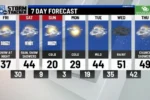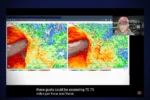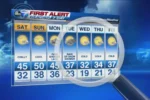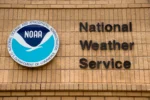Have you ever felt like the weather just can’t make up its mind? Well, millions of people across the United States are about to experience something called “weather whiplash!” This means that some places will see their temperatures swing wildly—sometimes by as much as 90 degrees! Imagine waking up to freezing cold one day and then wearing shorts the next! This week, parts of the country are dealing with chilly temperatures, but next week, everyone will be enjoying warmer days. Let’s dive into how this crazy weather happens and what it means for us!
| Location | Current Temperature (°F) | Expected Temperature (°F) | Temperature Change (°F) |
|---|---|---|---|
| Dallas, Texas | 13 | 70 | +57° increase |
| Wichita, Kansas | -7 | 60 | +67° increase |
| Hettinger, North Dakota | -45 | 50 | +95° increase |
Understanding Weather Whiplash
Weather whiplash is a term used to describe sudden and extreme changes in temperature, often experienced in various parts of the United States. For example, many areas are experiencing drastic shifts from freezing temperatures to warm weather in just a few days. This phenomenon can be surprising and confusing for people, especially when they go from bundling up to wearing lighter clothes in such a short time.
These rapid temperature changes can impact daily life in many ways. Children may need to wear different clothing for school, and families might have to adjust their heating or cooling systems. Understanding weather whiplash is essential so we can prepare for these changes and stay safe while enjoying the warm weather that follows.
The Science Behind Temperature Swings
The significant temperature swings seen in weather whiplash are often caused by the movement of air masses. For instance, warm air from the North Pacific can push out cold Arctic air, leading to rapid changes in temperature. This week, many places in the U.S. experienced a cold snap, but warmer air is on the way, bringing relief and a much-needed warm-up.
Meteorologists study these air movements to forecast weather changes accurately. They use advanced tools to track the flow of air and predict when warmer temperatures will arrive. By understanding these patterns, we can better prepare for the swings in weather, ensuring that we stay comfortable and safe no matter what the temperature is outside.
Preparing for Extreme Weather Changes
When facing extreme weather changes, preparation is key. Families should check the weather forecast regularly to know what to expect. If a cold snap is followed by a warm-up, it’s essential to dress in layers and have appropriate clothing ready for both extremes. This way, everyone can stay comfortable regardless of the temperature outside.
Additionally, homeowners should ensure their heating and cooling systems are functioning properly. Preparing your home for sudden temperature changes can help save energy costs and keep everyone cozy. By being proactive and aware, we can enjoy the benefits of warmer weather while staying safe and comfortable during the transitions.
Understanding Weather Whiplash: What It Means for You
Weather whiplash refers to the rapid and extreme fluctuations in temperature that can occur in short periods. This phenomenon can be especially disorienting for many, as individuals transition from frigid conditions to unseasonably warm temperatures in just a few days. Such drastic changes can challenge our bodies’ ability to adapt, potentially affecting health and daily activities, which is important for everyone to consider when planning their week ahead.
Moreover, weather whiplash often disrupts typical seasonal patterns and can lead to increased energy consumption for heating and cooling. As temperatures swing from one extreme to another, residents may find themselves cranking up the heat one day and switching on the air conditioning the next. Understanding these shifts can help individuals prepare better, both physically and financially, for the associated costs and impacts.
The Science Behind Temperature Fluctuations: A Deeper Look at Weather Patterns and Systems
Weather fluctuations often stem from the complex interplay of atmospheric conditions, with various systems influencing temperatures across regions. Meteorologists analyze factors such as jet streams, pressure systems, and ocean currents to predict these swings. The recent weather changes are largely due to warmer air from the North Pacific displacing the cold Arctic air, which has led to this unusual temperature rollercoaster.
Additionally, understanding the science behind these fluctuations helps us appreciate the broader climate dynamics at play. For instance, the shift from cold to warm can be attributed to changes in air circulation patterns, which are influenced by other global phenomena. By studying these patterns, we can gain insights into future weather trends and better prepare for the impacts of climate change on our local environments.
Regions Most Affected: A Closer Look at Cities Experiencing Extreme Temperature Changes
Cities across the U.S. have been experiencing unprecedented temperature swings, often within a matter of days. For example, Dallas and Wichita are prime examples of how drastically the weather can change; from lows of 13 degrees to highs in the 70s, these fluctuations highlight the extreme variability of the current weather patterns. Such dramatic changes can have significant implications for agriculture, infrastructure, and community activities.
Furthermore, cities like Hettinger, North Dakota, showcase the extremes of this weather phenomenon, with temperatures plummeting to -45 degrees before soaring to nearly 50 degrees. These shifts can affect everything from farming practices to energy demands, making it crucial for residents and local governments to stay informed and prepared for such rapid changes in weather.
Preparing for the Shift: Tips for Navigating Drastic Weather Changes
As the weather shifts from cold to warm, it’s essential to adapt our daily routines accordingly. One of the best tips for managing such transitions is to dress in layers. This approach allows individuals to adjust to changing temperatures throughout the day, ensuring comfort and reducing the risk of getting sick due to exposure to extreme weather.
In addition, staying informed through reliable weather updates is key. By monitoring forecasts, you can plan your activities around expected temperature changes, whether it’s scheduling outdoor events during warmer times or ensuring your home is adequately heated during cold snaps. Awareness and preparation can make navigating these fluctuations much more manageable.
The Broader Implications of Climate Change on Weather Patterns
The extreme weather fluctuations we’re witnessing are not just isolated incidents; they are indicative of broader climate change influences. As global temperatures rise, weather patterns become more unpredictable, leading to more frequent occurrences of phenomena like weather whiplash. This unpredictability can have far-reaching effects on agriculture, wildlife, and human health, making it crucial to address these changes collectively.
Moreover, understanding the connection between climate change and extreme weather can foster greater awareness and action among communities. By encouraging discussions about sustainability and proactive measures to mitigate climate impacts, we can work towards a more resilient future, ensuring that we are better prepared for the unpredictable nature of our environment.
Frequently Asked Questions
What is weather whiplash and why is it happening?
**Weather whiplash** is when temperatures change very quickly, like going from cold to hot. It’s happening because warm air from the North Pacific is pushing out cold Arctic air.
How much will temperatures change in some places next week?
In some areas, temperatures will change by **90 degrees**! For example, Dallas will go from **13 degrees** to the **70s** in just a few days.
What causes the drastic temperature changes across the US?
These changes are caused by **air movements**. Warm air comes in from the ocean, pushing away the cold air from the Arctic, leading to a big temperature swing.
Which cities will see the biggest temperature changes?
Cities like **Dallas**, **Wichita**, and **Hettinger** will see the biggest changes, with differences of **50 to 90 degrees** in just a few days!
What is the weather like in North Dakota right now?
Right now, North Dakota is very cold, with temperatures around **-45 degrees**. But soon, it will warm up to nearly **50 degrees**!
How does this weather change affect people in the US?
This weather change can affect **how people dress**, travel plans, and even how they feel. A sudden warm-up can make people feel happier and more energetic!
When will the warmer weather start to arrive?
The **warmer weather** will start arriving on **Saturday**, first in the West, then moving east over the next week, bringing relief from the cold!
Summary
The content discusses the expected dramatic weather changes across the US, predicting significant temperature swings for millions. Following a week of below-average temperatures, nearly 75% of Americans will experience a warm-up next week, with highs potentially reaching 70-90 degrees higher than this week’s lows. Meteorologist Stephen Morgan notes this may resemble typical late February weather. Areas from North Dakota to Texas will see the most drastic fluctuations, with extreme examples like Hettinger, ND, experiencing a 90-degree shift. This change is driven by warmer air from the North Pacific replacing the Arctic cold, leading to a widespread increase in temperatures.







